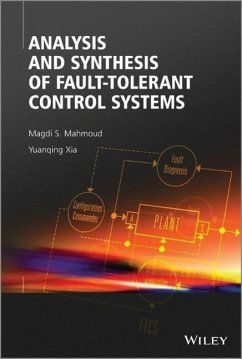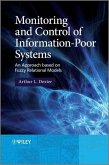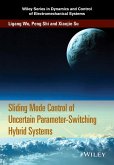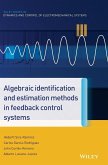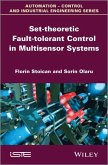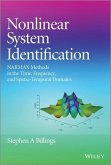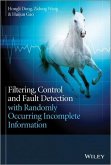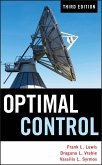- Gebundenes Buch
- Merkliste
- Auf die Merkliste
- Bewerten Bewerten
- Teilen
- Produkt teilen
- Produkterinnerung
- Produkterinnerung
Analysis and Synthesis of Fault-Tolerant Control Systems presents methods for developing controllers and filters for a wide class of dynamical systems. Comprehensively reporting on recent advances in design methodologies, the text features a number of case studies, MATLAB throughout to demonstrate methods of analysis and design, examples, problems, and end-of-chapter notes, as well as a companion website containing MATLAB and Simulink files.
In recent years, control systems have become more sophisticated in order to meet increased performance and safety requirements for modern technological…mehr
Andere Kunden interessierten sich auch für
![Monitoring and Control of Information-Poor Systems Monitoring and Control of Information-Poor Systems]() Arthur L. DexterMonitoring and Control of Information-Poor Systems139,99 €
Arthur L. DexterMonitoring and Control of Information-Poor Systems139,99 €![Sliding Mode Control of Uncertain Parameter-Switching Hybrid Systems Sliding Mode Control of Uncertain Parameter-Switching Hybrid Systems]() Ligang WuSliding Mode Control of Uncertain Parameter-Switching Hybrid Systems139,99 €
Ligang WuSliding Mode Control of Uncertain Parameter-Switching Hybrid Systems139,99 €![Algebraic Identification and Estimation Methods in Feedback Control Systems Algebraic Identification and Estimation Methods in Feedback Control Systems]() Hebertt Sira-RamírezAlgebraic Identification and Estimation Methods in Feedback Control Systems134,99 €
Hebertt Sira-RamírezAlgebraic Identification and Estimation Methods in Feedback Control Systems134,99 €![Set-Theoretic Fault-Tolerant Control in Multisensor Systems Set-Theoretic Fault-Tolerant Control in Multisensor Systems]() Florin StoicanSet-Theoretic Fault-Tolerant Control in Multisensor Systems169,99 €
Florin StoicanSet-Theoretic Fault-Tolerant Control in Multisensor Systems169,99 €![Nonlinear System Identification Nonlinear System Identification]() Stephen A. BillingsNonlinear System Identification160,99 €
Stephen A. BillingsNonlinear System Identification160,99 €![Filtering, Control and Fault Detection with Randomly Occurring Incomplete Information Filtering, Control and Fault Detection with Randomly Occurring Incomplete Information]() Hongli DongFiltering, Control and Fault Detection with Randomly Occurring Incomplete Information143,99 €
Hongli DongFiltering, Control and Fault Detection with Randomly Occurring Incomplete Information143,99 €![Optimal Control Optimal Control]() Frank L. LewisOptimal Control175,99 €
Frank L. LewisOptimal Control175,99 €-
-
-
Analysis and Synthesis of Fault-Tolerant Control Systems presents methods for developing controllers and filters for a wide class of dynamical systems. Comprehensively reporting on recent advances in design methodologies, the text features a number of case studies, MATLAB throughout to demonstrate methods of analysis and design, examples, problems, and end-of-chapter notes, as well as a companion website containing MATLAB and Simulink files.
In recent years, control systems have become more sophisticated in order to meet increased performance and safety requirements for modern technological systems. Engineers are becoming more aware that conventional feedback control design for a complex system may result in unsatisfactory performance, or even instability, in the event of malfunctions in actuators, sensors or other system components. In order to circumvent such weaknesses, new approaches to control system design have emerged which can tolerate component malfunctions while maintaining acceptable stability and performance. These types of control systems are often known as fault-tolerant control systems (FTCS). More precisely, FTCS are control systems which possess the ability to accommodate component failure automatically.
Analysis and Synthesis of Fault-Tolerant Control Systems comprehensively covers the analysis and synthesis methods of fault tolerant control systems. It unifies the methods for developing controllers and filters for a wide class of dynamical systems and reports on the recent technical advances in design methodologies. MATLAB(r) is used throughout the book, to demonstrate methods of analysis and design.
Key features:
Provides advanced theoretical methods and typical practical applications
Provides access to a spectrum of control design methods applied to industrial systems
Includes case studies and illustrative examples
Contains end-of-chapter problems
Analysis and Synthesis of Fault-Tolerant Control Systems is a comprehensive reference for researchers and practitioners working in this area, and is also a valuable source of information for graduates and senior undergraduates in control, mechanical, aerospace, electrical and mechatronics engineering departments.
Hinweis: Dieser Artikel kann nur an eine deutsche Lieferadresse ausgeliefert werden.
In recent years, control systems have become more sophisticated in order to meet increased performance and safety requirements for modern technological systems. Engineers are becoming more aware that conventional feedback control design for a complex system may result in unsatisfactory performance, or even instability, in the event of malfunctions in actuators, sensors or other system components. In order to circumvent such weaknesses, new approaches to control system design have emerged which can tolerate component malfunctions while maintaining acceptable stability and performance. These types of control systems are often known as fault-tolerant control systems (FTCS). More precisely, FTCS are control systems which possess the ability to accommodate component failure automatically.
Analysis and Synthesis of Fault-Tolerant Control Systems comprehensively covers the analysis and synthesis methods of fault tolerant control systems. It unifies the methods for developing controllers and filters for a wide class of dynamical systems and reports on the recent technical advances in design methodologies. MATLAB(r) is used throughout the book, to demonstrate methods of analysis and design.
Key features:
Provides advanced theoretical methods and typical practical applications
Provides access to a spectrum of control design methods applied to industrial systems
Includes case studies and illustrative examples
Contains end-of-chapter problems
Analysis and Synthesis of Fault-Tolerant Control Systems is a comprehensive reference for researchers and practitioners working in this area, and is also a valuable source of information for graduates and senior undergraduates in control, mechanical, aerospace, electrical and mechatronics engineering departments.
Hinweis: Dieser Artikel kann nur an eine deutsche Lieferadresse ausgeliefert werden.
Produktdetails
- Produktdetails
- Verlag: Wiley & Sons
- 1. Auflage
- Seitenzahl: 480
- Erscheinungstermin: 7. Januar 2014
- Englisch
- Abmessung: 244mm x 168mm x 28mm
- Gewicht: 862g
- ISBN-13: 9781118541333
- ISBN-10: 1118541332
- Artikelnr.: 40051648
- Herstellerkennzeichnung
- Libri GmbH
- Europaallee 1
- 36244 Bad Hersfeld
- gpsr@libri.de
- Verlag: Wiley & Sons
- 1. Auflage
- Seitenzahl: 480
- Erscheinungstermin: 7. Januar 2014
- Englisch
- Abmessung: 244mm x 168mm x 28mm
- Gewicht: 862g
- ISBN-13: 9781118541333
- ISBN-10: 1118541332
- Artikelnr.: 40051648
- Herstellerkennzeichnung
- Libri GmbH
- Europaallee 1
- 36244 Bad Hersfeld
- gpsr@libri.de
MagdiSadek Mahmoud obtained Ph. D. in systems engineering from Cairo University, 1974. He has been a professor of engineering since 1984. He is now a Distinguished University Professor at KFUPM, Saudi Arabia. He worked at different universities world-wide including Egypt, Kuwait, UAE, UK, USA, Singapore and Australia.He lectured in Venezuela, Germany, UK, USA, Canada and China. He has been actively engaged in teaching and research in the development of modern methodologies to distributed control and filtering, switched time-delay systems, fault-tolerant systems and information technology. He is the principal author of thirty (30) books, inclusive book-chapters and the author/co-author of more than 500 peer-reviewed papers. He is the recipient of two national, one regional and four university prizes for outstanding research in engineering. He is a fellow of the IEE, a senior member of the IEEE, the CEI (UK), and a registered consultant engineer of information engineering and systems (Egypt). Email: magdim@yahoo.com, msmahmoud@kfupm.edu.sa, Website: http://faculty.kfupm.edu.sa/se/msmahmoud/ Dr. Yuanqing Xia received his M.S. degree in Fundamental Mathematics from Anhui University, China, in 1998 and his Ph.D. Degree in Control Theory and Control Engineering from Beijing University of Aeronautics and Astronautics, Beijing, China, in 2001. From 1991-1995, he was with Tongcheng Middle-School, Anhui, China, where he worked as a teacher. During January 2002-November 2003, he was a postdoctoral research associate in the Institute of Systems Science, Academy of Mathematics and System Sciences, Chinese Academy of Sciences, Beijing, China, where he worked on navigation, guidance and control. From November 2003 to February 2004, he was with the National University of Singapore as a research fellow, where he worked on variable structure control. From February 2004 to February 2006, he was with the University of Glamorgan, Pontypridd, U.K., as a Research Fellow, where he worked on networked control systems. From February 2007 to June 2008, he was a Guest Professor with Innsbruck Medical University, Innsbruck, Austria, where he worked on biomedical signal processing. Since July 2004, he has been with the Department of Automatic Control, Beijing Institute of Technology, Beijing, first as an Associate Professor, then, since 2008, as a Professor and in 2012. He has published five monographs in Springer and more than 100 papers in journals. He was appointed as ``Xu Teli" distinguished professor in Beijing Institute of Technology and obtained National Science Foundation for Distinguished Young Scholars of China. He was obtained Second Award of Beijing Municipal Science and Technology (No.1) in 2010 , Second National Award for Science and Technology (No.2) in 2011, and second natural science award of The Ministry of Education in 2012. He is an editor in deputy of Journal of Beijing Institute of Technology, associate editor of Acta Automatica Sinica, International Journal of Innovative Computing, Information and Control.
Preface xv
Acknowledgments xvii
1 Introduction 1
1.1 Overview 1
1.2 Basic Concepts of Faults 2
1.3 Classification of Fault Detection Methods 3
1.3.1 Hardware redundancy based fault detection 3
1.3.2 Plausibility test 3
1.3.3 Signal-based fault diagnosis 4
1.3.4 Model-based fault detection 5
1.4 Types of Fault-Tolerant Control System 8
1.5 Objectives and Structure of AFTCS 8
1.6 Classification of Reconfigurable Control Methods 10
1.6.1 Classification based on control algorithms 10
1.6.2 Classification based on field of application 11
1.7 Outline of the Book 11
1.7.1 Methodology 11
1.7.2 Chapter organization 12
1.8 Notes 13
References 13
2 Fault Diagnosis and Detection 17
2.1 Introduction 17
2.2 Related Work 17
2.2.1 Model-based schemes 17
2.2.2 Model-free schemes 18
2.2.3 Probabilistic schemes 19
2.3 Integrated Approach 19
2.3.1 Improved multi-sensor data fusion 19
2.3.2 Unscented transformation 21
2.3.3 Unscented Kalman filter 22
2.3.4 Parameter estimation 23
2.3.5 Multi-sensor integration architectures 24
2.4 Robust Unscented Kalman Filter 26
2.4.1 Introduction 26
2.4.2 Problem formulation 28
2.4.3 Residual generation 29
2.4.4 Residual evaluation 29
2.5 Quadruple Tank System 30
2.5.1 Model of the QTS 31
2.5.2 Fault scenarios in QTS 32
2.5.3 Implementation structure of UKF 33
2.5.4 UKF with centralized multi-sensor data fusion 35
2.5.5 UKF with decentralized multi-sensor data fusion 35
2.5.6 Drift detection 35
2.6 Industrial Utility Boiler 38
2.6.1 Steam flow dynamics 38
2.6.2 Drum pressure dynamics 40
2.6.3 Drum level dynamics 40
2.6.4 Steam temperature 41
2.6.5 Fault model for the utility boiler 42
2.6.6 Fault scenarios in the utility boiler 43
2.6.7 UKF with centralized multi-sensor data fusion 43
2.6.8 UKF with decentralized multi-sensor data fusion 43
2.6.9 Drift detection 45
2.6.10 Remarks 45
2.7 Notes 46
References 46
3 Robust Fault Detection 49
3.1 Distributed Fault Diagnosis 49
3.1.1 Introduction 49
3.1.2 System model 50
3.1.3 Distributed FDI architecture 55
3.1.4 Distributed fault detection method 55
3.1.5 Adaptive thresholds 57
3.1.6 Distributed fault isolation method 62
3.1.7 Adaptive thresholds for DFDI 64
3.1.8 Fault detectability condition 67
3.1.9 Fault isolability analysis 69
3.1.10 Stability and learning capability 71
3.2 Robust Fault Detection Filters 74
3.2.1 Reference model 74
3.2.2 Design of adaptive threshold 76
3.2.3 Iterative update of noise mean and covariance 77
3.2.4 Unscented transformation (UT) 79
3.2.5 Car-like mobile robot application 82
3.3 Simultaneous Fault Detection and Control 90
3.3.1 Introduction 93
3.3.2 System model 93
3.3.3 Problem formulation 95
3.3.4 Simultaneous fault detection and control problem 96
3.3.5 Two-tank system simulation 106
3.4 Data-Driven Fault Detection Design 108
3.4.1 Introduction 109
3.4.2 Problem formulation 111
3.4.3 Selection of weighting matrix 112
3.4.4 Design of FDF for time-delay system 113
3.4.5 LMI design approach 114
3.4.6 Four-tank system simulation 119
3.5 Robust Adaptive Fault Estimation 122
3.5.1 Introduction 124
3.5.2 Problem statement 125
3.5.3 Adaptive observer 127
3.6 Notes 131
References 131
4 Fault-Tolerant Control Systems 135
4.1 Model Prediction-Based Design Approach 135
4.1.1 Introduction 135
4.1.2 System description 136
4.1.3 Discrete-time UKF 138
4.1.4 Unscented Transformation (UT) 141
4.1.5 Controller reconfiguration 143
4.1.6 Model predictive control 144
4.1.7 Interconnected CSTR units 149
4.1.8 Four-tank system 151
4.1.9 Simulation results 152
4.1.10 Drift detection in the interconnected CSTRs 152
4.1.11 Information fusion from UKF 152
4.1.12 Drift detection in the four-tank system 156
4.2 Observer-Based Active Structures 160
4.2.1 Problem statement 160
4.2.2 A separation principle 162
4.2.3 FDI residuals 164
4.2.4 Control of integrity 164
4.2.5 Overall stability 165
4.2.6 Design outline 165
4.2.7 Design of an active FTC scheme 166
4.2.8 Extraction of FDI-FTC pairs 166
4.2.9 Simulation 169
4.3 Notes 172
References 172
5 Fault-Tolerant Nonlinear Control Systems 175
5.1 Comparison of Fault Detection Schemes 175
5.2 Fault Detection in Nonlinear Systems 176
5.3 Nonlinear Observer-Based Residual Generation Schemes 176
5.3.1 General considerations 176
5.3.2 Extended Luenberger observer 177
5.3.3 Nonlinear identity observer approach 177
5.3.4 Unknown input observer approach 178
5.3.5 The disturbance decoupling nonlinear observer approach 178
5.3.6 Adaptive nonlinear observer approach 178
5.3.7 High-gain observer approach 178
5.3.8 Sliding-mode observer approach 178
5.3.9 Geometric approach 179
5.3.10 Game-theoretic approach 179
5.3.11 Observers for Lipschitz nonlinear systems 179
5.3.12 Lyapunov-reconstruction-based passive scheme 180
5.3.13 Time-varying results 185
5.3.14 Optimization-based active scheme 187
5.3.15 Learning-based active scheme 190
5.3.16 Adaptive backstepping-based active scheme 191
5.3.17 Switched control-based active scheme 193
5.3.18 Predictive control-based active scheme 195
5.4 Integrated Control Reconfiguration Scheme 197
5.4.1 Introduction 197
5.4.2 Basic features 198
5.4.3 Nonlinear model of a pendulum on a cart 199
5.4.4 NGA adaptive filter design 201
5.4.5 Simulation results 207
5.4.6 Performance evaluation 209
5.4.7 Comparative studies 211
5.5 Notes 215
References 215
6 Robust Fault Estimation 219
6.1 Introduction 219
6.2 System Description 220
6.3 Multiconstrained Fault Estimation 221
6.3.1 Observer design 221
6.3.2 Existence conditions 226
6.3.3 Improved results 228
6.3.4 Simulation results 232
6.4 Adaptive Fault Estimation 235
6.4.1 Introduction 236
6.4.2 Problem statement 238
6.4.3 Robust adaptive estimation 239
6.4.4 Internal stability analysis 240
6.4.5 Robust performance index 241
6.4.6 Simulation 242
6.5 Adaptive Tracking Control Scheme 244
6.5.1 Attitude dynamics 244
6.5.2 Fault detection scheme 248
6.5.3 Fault-tolerant tracking scheme 250
6.6 Notes 254
References 254
7 Fault Detection of Networked Control Systems 257
7.1 Introduction 257
7.2 Problem Formulation 258
7.3 Modified Residual Generator Scheme 259
7.3.1 Modified residual generator and dynamic analysis 259
7.3.2 Residual evaluation 261
7.3.3 Co-design of residual generator and evaluation 264
7.4 Quantized Fault-Tolerant Control 267
7.4.1 Introduction 267
7.4.2 Problem statement 268
7.4.3 Quantized control design 271
7.4.4 Simulation 276
7.5 Sliding-Mode Observer 278
7.5.1 Introduction 278
7.5.2 Dynamic model 280
7.5.3 Limited state measurements 286
7.5.4 Simulation results: full state measurements 290
7.5.5 Simulation results: partial state measurements 293
7.6 Control of Linear Switched Systems 294
7.6.1 Introduction 295
7.6.2 Problem formulation 295
7.6.3 Stability of a closed-loop system 296
7.6.4 Simulation 300
7.7 Notes 303
References 303
8 Industrial Fault-Tolerant Architectures 307
8.1 Introduction 307
8.2 System Architecture 308
8.3 Architecture of a Fault-Tolerant Node 309
8.3.1 Basic architecture 309
8.3.2 Architecture with improved reliability 310
8.3.3 Symmetric node architecture 310
8.3.4 Results 311
8.4 Recovery Points 312
8.5 Networks 314
8.6 System Fault Injection and Monitoring 315
8.6.1 Monitoring systems 315
8.6.2 Design methodology 316
8.7 Notes 318
References 319
9 Fault Estimation for Stochastic Systems 321
9.1 Introduction 321
9.2 Actuator Fault Diagnosis Design 322
9.3 Fault-Tolerant Controller Design 324
9.4 Extension to an Unknown Input Case 325
9.5 Aircraft Application 326
9.5.1 Transforming the system into standard form 327
9.5.2 Simulation results 329
9.6 Router Fault Accommodation in Real Time 330
9.6.1 Canonical controller and achievable behavior 333
9.6.2 Router modeling and desired behavior 334
9.6.3 Description of fault behavior 336
9.6.4 A least restrictive controller 338
9.7 Fault Detection for Markov Jump Systems 338
9.7.1 Introduction 339
9.7.2 Problem formulation 340
9.7.3 H infinity bounded real lemmas 343
9.7.4 H infinity FD filter design 345
9.7.5 Simulation 347
9.8 Notes 352
References 353
10 Applications 355
10.1 Detection of Abrupt Changes in an Electrocardiogram 355
10.1.1 Introduction 355
10.1.2 Modeling ECG signals with an AR model 356
10.1.3 Linear models with additive abrupt changes 358
10.1.4 Off-line detection of abrupt changes in ECG 361
10.1.5 Online detection of abrupt changes in ECG 363
10.2 Detection of Abrupt Changes in the Frequency Domain 365
10.2.1 Introduction 365
10.2.2 Problem formulation 366
10.2.3 Frequency domain ML ratio estimation 368
10.2.4 Likelihood of the hypothesis of no abrupt change 372
10.2.5 Effect of an abrupt change 374
10.2.6 Simulation results 382
10.3 Electromechanical Positioning System 383
10.3.1 Introduction 383
10.3.2 Problem formulation 385
10.3.3 Test bed 386
10.4 Application to Fermentation Processes 387
10.4.1 Nonlinear faulty dynamic system 388
10.4.2 Residual characteristics 389
10.4.3 The parameter filter 399
10.4.4 Fault filter 400
10.4.5 Fault isolation and identification 401
10.4.6 Isolation speed 401
10.4.7 Parameter partition 402
10.4.8 Adaptive intervals 402
10.4.9 Simulation studies 405
10.5 Flexible-Joint Robots 415
10.5.1 Problem formulation 415
10.5.2 Fault detection scheme 417
10.5.3 Adaptive fault accommodation control 420
10.5.4 Control with prescribed performance bounds 422
10.5.5 Simulation results 425
10.6 Notes 429
References 430
A Supplementary Information 435
A.1 Notation 435
A.1.1 Kronecker products 436
A.1.2 Some definitions 437
A.1.3 Matrix lemmas 438
A.2 Results from Probability Theory 440
A.2.1 Results-A 440
A.2.2 Results-B 441
A.2.3 Results-C 441
A.2.4 Minimum mean square estimate 442
A.3 Stability Notions 444
A.3.1 Practical stabilizability 444
A.3.2 Razumikhin stability 445
A.4 Basic Inequalities 447
A.4.1 Schur complements 447
A.4.2 Bounding inequalities 449
A.5 Linear Matrix Inequalities 453
A.5.1 Basics 453
A.5.2 Some standard problems 454
A.5.3 The S-procedure 455
A.6 Some Formulas on Matrix Inverses 456
A.6.1 Inverse of block matrices 456
A.6.2 Matrix inversion lemma 457
References 458
Index 459
Acknowledgments xvii
1 Introduction 1
1.1 Overview 1
1.2 Basic Concepts of Faults 2
1.3 Classification of Fault Detection Methods 3
1.3.1 Hardware redundancy based fault detection 3
1.3.2 Plausibility test 3
1.3.3 Signal-based fault diagnosis 4
1.3.4 Model-based fault detection 5
1.4 Types of Fault-Tolerant Control System 8
1.5 Objectives and Structure of AFTCS 8
1.6 Classification of Reconfigurable Control Methods 10
1.6.1 Classification based on control algorithms 10
1.6.2 Classification based on field of application 11
1.7 Outline of the Book 11
1.7.1 Methodology 11
1.7.2 Chapter organization 12
1.8 Notes 13
References 13
2 Fault Diagnosis and Detection 17
2.1 Introduction 17
2.2 Related Work 17
2.2.1 Model-based schemes 17
2.2.2 Model-free schemes 18
2.2.3 Probabilistic schemes 19
2.3 Integrated Approach 19
2.3.1 Improved multi-sensor data fusion 19
2.3.2 Unscented transformation 21
2.3.3 Unscented Kalman filter 22
2.3.4 Parameter estimation 23
2.3.5 Multi-sensor integration architectures 24
2.4 Robust Unscented Kalman Filter 26
2.4.1 Introduction 26
2.4.2 Problem formulation 28
2.4.3 Residual generation 29
2.4.4 Residual evaluation 29
2.5 Quadruple Tank System 30
2.5.1 Model of the QTS 31
2.5.2 Fault scenarios in QTS 32
2.5.3 Implementation structure of UKF 33
2.5.4 UKF with centralized multi-sensor data fusion 35
2.5.5 UKF with decentralized multi-sensor data fusion 35
2.5.6 Drift detection 35
2.6 Industrial Utility Boiler 38
2.6.1 Steam flow dynamics 38
2.6.2 Drum pressure dynamics 40
2.6.3 Drum level dynamics 40
2.6.4 Steam temperature 41
2.6.5 Fault model for the utility boiler 42
2.6.6 Fault scenarios in the utility boiler 43
2.6.7 UKF with centralized multi-sensor data fusion 43
2.6.8 UKF with decentralized multi-sensor data fusion 43
2.6.9 Drift detection 45
2.6.10 Remarks 45
2.7 Notes 46
References 46
3 Robust Fault Detection 49
3.1 Distributed Fault Diagnosis 49
3.1.1 Introduction 49
3.1.2 System model 50
3.1.3 Distributed FDI architecture 55
3.1.4 Distributed fault detection method 55
3.1.5 Adaptive thresholds 57
3.1.6 Distributed fault isolation method 62
3.1.7 Adaptive thresholds for DFDI 64
3.1.8 Fault detectability condition 67
3.1.9 Fault isolability analysis 69
3.1.10 Stability and learning capability 71
3.2 Robust Fault Detection Filters 74
3.2.1 Reference model 74
3.2.2 Design of adaptive threshold 76
3.2.3 Iterative update of noise mean and covariance 77
3.2.4 Unscented transformation (UT) 79
3.2.5 Car-like mobile robot application 82
3.3 Simultaneous Fault Detection and Control 90
3.3.1 Introduction 93
3.3.2 System model 93
3.3.3 Problem formulation 95
3.3.4 Simultaneous fault detection and control problem 96
3.3.5 Two-tank system simulation 106
3.4 Data-Driven Fault Detection Design 108
3.4.1 Introduction 109
3.4.2 Problem formulation 111
3.4.3 Selection of weighting matrix 112
3.4.4 Design of FDF for time-delay system 113
3.4.5 LMI design approach 114
3.4.6 Four-tank system simulation 119
3.5 Robust Adaptive Fault Estimation 122
3.5.1 Introduction 124
3.5.2 Problem statement 125
3.5.3 Adaptive observer 127
3.6 Notes 131
References 131
4 Fault-Tolerant Control Systems 135
4.1 Model Prediction-Based Design Approach 135
4.1.1 Introduction 135
4.1.2 System description 136
4.1.3 Discrete-time UKF 138
4.1.4 Unscented Transformation (UT) 141
4.1.5 Controller reconfiguration 143
4.1.6 Model predictive control 144
4.1.7 Interconnected CSTR units 149
4.1.8 Four-tank system 151
4.1.9 Simulation results 152
4.1.10 Drift detection in the interconnected CSTRs 152
4.1.11 Information fusion from UKF 152
4.1.12 Drift detection in the four-tank system 156
4.2 Observer-Based Active Structures 160
4.2.1 Problem statement 160
4.2.2 A separation principle 162
4.2.3 FDI residuals 164
4.2.4 Control of integrity 164
4.2.5 Overall stability 165
4.2.6 Design outline 165
4.2.7 Design of an active FTC scheme 166
4.2.8 Extraction of FDI-FTC pairs 166
4.2.9 Simulation 169
4.3 Notes 172
References 172
5 Fault-Tolerant Nonlinear Control Systems 175
5.1 Comparison of Fault Detection Schemes 175
5.2 Fault Detection in Nonlinear Systems 176
5.3 Nonlinear Observer-Based Residual Generation Schemes 176
5.3.1 General considerations 176
5.3.2 Extended Luenberger observer 177
5.3.3 Nonlinear identity observer approach 177
5.3.4 Unknown input observer approach 178
5.3.5 The disturbance decoupling nonlinear observer approach 178
5.3.6 Adaptive nonlinear observer approach 178
5.3.7 High-gain observer approach 178
5.3.8 Sliding-mode observer approach 178
5.3.9 Geometric approach 179
5.3.10 Game-theoretic approach 179
5.3.11 Observers for Lipschitz nonlinear systems 179
5.3.12 Lyapunov-reconstruction-based passive scheme 180
5.3.13 Time-varying results 185
5.3.14 Optimization-based active scheme 187
5.3.15 Learning-based active scheme 190
5.3.16 Adaptive backstepping-based active scheme 191
5.3.17 Switched control-based active scheme 193
5.3.18 Predictive control-based active scheme 195
5.4 Integrated Control Reconfiguration Scheme 197
5.4.1 Introduction 197
5.4.2 Basic features 198
5.4.3 Nonlinear model of a pendulum on a cart 199
5.4.4 NGA adaptive filter design 201
5.4.5 Simulation results 207
5.4.6 Performance evaluation 209
5.4.7 Comparative studies 211
5.5 Notes 215
References 215
6 Robust Fault Estimation 219
6.1 Introduction 219
6.2 System Description 220
6.3 Multiconstrained Fault Estimation 221
6.3.1 Observer design 221
6.3.2 Existence conditions 226
6.3.3 Improved results 228
6.3.4 Simulation results 232
6.4 Adaptive Fault Estimation 235
6.4.1 Introduction 236
6.4.2 Problem statement 238
6.4.3 Robust adaptive estimation 239
6.4.4 Internal stability analysis 240
6.4.5 Robust performance index 241
6.4.6 Simulation 242
6.5 Adaptive Tracking Control Scheme 244
6.5.1 Attitude dynamics 244
6.5.2 Fault detection scheme 248
6.5.3 Fault-tolerant tracking scheme 250
6.6 Notes 254
References 254
7 Fault Detection of Networked Control Systems 257
7.1 Introduction 257
7.2 Problem Formulation 258
7.3 Modified Residual Generator Scheme 259
7.3.1 Modified residual generator and dynamic analysis 259
7.3.2 Residual evaluation 261
7.3.3 Co-design of residual generator and evaluation 264
7.4 Quantized Fault-Tolerant Control 267
7.4.1 Introduction 267
7.4.2 Problem statement 268
7.4.3 Quantized control design 271
7.4.4 Simulation 276
7.5 Sliding-Mode Observer 278
7.5.1 Introduction 278
7.5.2 Dynamic model 280
7.5.3 Limited state measurements 286
7.5.4 Simulation results: full state measurements 290
7.5.5 Simulation results: partial state measurements 293
7.6 Control of Linear Switched Systems 294
7.6.1 Introduction 295
7.6.2 Problem formulation 295
7.6.3 Stability of a closed-loop system 296
7.6.4 Simulation 300
7.7 Notes 303
References 303
8 Industrial Fault-Tolerant Architectures 307
8.1 Introduction 307
8.2 System Architecture 308
8.3 Architecture of a Fault-Tolerant Node 309
8.3.1 Basic architecture 309
8.3.2 Architecture with improved reliability 310
8.3.3 Symmetric node architecture 310
8.3.4 Results 311
8.4 Recovery Points 312
8.5 Networks 314
8.6 System Fault Injection and Monitoring 315
8.6.1 Monitoring systems 315
8.6.2 Design methodology 316
8.7 Notes 318
References 319
9 Fault Estimation for Stochastic Systems 321
9.1 Introduction 321
9.2 Actuator Fault Diagnosis Design 322
9.3 Fault-Tolerant Controller Design 324
9.4 Extension to an Unknown Input Case 325
9.5 Aircraft Application 326
9.5.1 Transforming the system into standard form 327
9.5.2 Simulation results 329
9.6 Router Fault Accommodation in Real Time 330
9.6.1 Canonical controller and achievable behavior 333
9.6.2 Router modeling and desired behavior 334
9.6.3 Description of fault behavior 336
9.6.4 A least restrictive controller 338
9.7 Fault Detection for Markov Jump Systems 338
9.7.1 Introduction 339
9.7.2 Problem formulation 340
9.7.3 H infinity bounded real lemmas 343
9.7.4 H infinity FD filter design 345
9.7.5 Simulation 347
9.8 Notes 352
References 353
10 Applications 355
10.1 Detection of Abrupt Changes in an Electrocardiogram 355
10.1.1 Introduction 355
10.1.2 Modeling ECG signals with an AR model 356
10.1.3 Linear models with additive abrupt changes 358
10.1.4 Off-line detection of abrupt changes in ECG 361
10.1.5 Online detection of abrupt changes in ECG 363
10.2 Detection of Abrupt Changes in the Frequency Domain 365
10.2.1 Introduction 365
10.2.2 Problem formulation 366
10.2.3 Frequency domain ML ratio estimation 368
10.2.4 Likelihood of the hypothesis of no abrupt change 372
10.2.5 Effect of an abrupt change 374
10.2.6 Simulation results 382
10.3 Electromechanical Positioning System 383
10.3.1 Introduction 383
10.3.2 Problem formulation 385
10.3.3 Test bed 386
10.4 Application to Fermentation Processes 387
10.4.1 Nonlinear faulty dynamic system 388
10.4.2 Residual characteristics 389
10.4.3 The parameter filter 399
10.4.4 Fault filter 400
10.4.5 Fault isolation and identification 401
10.4.6 Isolation speed 401
10.4.7 Parameter partition 402
10.4.8 Adaptive intervals 402
10.4.9 Simulation studies 405
10.5 Flexible-Joint Robots 415
10.5.1 Problem formulation 415
10.5.2 Fault detection scheme 417
10.5.3 Adaptive fault accommodation control 420
10.5.4 Control with prescribed performance bounds 422
10.5.5 Simulation results 425
10.6 Notes 429
References 430
A Supplementary Information 435
A.1 Notation 435
A.1.1 Kronecker products 436
A.1.2 Some definitions 437
A.1.3 Matrix lemmas 438
A.2 Results from Probability Theory 440
A.2.1 Results-A 440
A.2.2 Results-B 441
A.2.3 Results-C 441
A.2.4 Minimum mean square estimate 442
A.3 Stability Notions 444
A.3.1 Practical stabilizability 444
A.3.2 Razumikhin stability 445
A.4 Basic Inequalities 447
A.4.1 Schur complements 447
A.4.2 Bounding inequalities 449
A.5 Linear Matrix Inequalities 453
A.5.1 Basics 453
A.5.2 Some standard problems 454
A.5.3 The S-procedure 455
A.6 Some Formulas on Matrix Inverses 456
A.6.1 Inverse of block matrices 456
A.6.2 Matrix inversion lemma 457
References 458
Index 459
Preface xv
Acknowledgments xvii
1 Introduction 1
1.1 Overview 1
1.2 Basic Concepts of Faults 2
1.3 Classification of Fault Detection Methods 3
1.3.1 Hardware redundancy based fault detection 3
1.3.2 Plausibility test 3
1.3.3 Signal-based fault diagnosis 4
1.3.4 Model-based fault detection 5
1.4 Types of Fault-Tolerant Control System 8
1.5 Objectives and Structure of AFTCS 8
1.6 Classification of Reconfigurable Control Methods 10
1.6.1 Classification based on control algorithms 10
1.6.2 Classification based on field of application 11
1.7 Outline of the Book 11
1.7.1 Methodology 11
1.7.2 Chapter organization 12
1.8 Notes 13
References 13
2 Fault Diagnosis and Detection 17
2.1 Introduction 17
2.2 Related Work 17
2.2.1 Model-based schemes 17
2.2.2 Model-free schemes 18
2.2.3 Probabilistic schemes 19
2.3 Integrated Approach 19
2.3.1 Improved multi-sensor data fusion 19
2.3.2 Unscented transformation 21
2.3.3 Unscented Kalman filter 22
2.3.4 Parameter estimation 23
2.3.5 Multi-sensor integration architectures 24
2.4 Robust Unscented Kalman Filter 26
2.4.1 Introduction 26
2.4.2 Problem formulation 28
2.4.3 Residual generation 29
2.4.4 Residual evaluation 29
2.5 Quadruple Tank System 30
2.5.1 Model of the QTS 31
2.5.2 Fault scenarios in QTS 32
2.5.3 Implementation structure of UKF 33
2.5.4 UKF with centralized multi-sensor data fusion 35
2.5.5 UKF with decentralized multi-sensor data fusion 35
2.5.6 Drift detection 35
2.6 Industrial Utility Boiler 38
2.6.1 Steam flow dynamics 38
2.6.2 Drum pressure dynamics 40
2.6.3 Drum level dynamics 40
2.6.4 Steam temperature 41
2.6.5 Fault model for the utility boiler 42
2.6.6 Fault scenarios in the utility boiler 43
2.6.7 UKF with centralized multi-sensor data fusion 43
2.6.8 UKF with decentralized multi-sensor data fusion 43
2.6.9 Drift detection 45
2.6.10 Remarks 45
2.7 Notes 46
References 46
3 Robust Fault Detection 49
3.1 Distributed Fault Diagnosis 49
3.1.1 Introduction 49
3.1.2 System model 50
3.1.3 Distributed FDI architecture 55
3.1.4 Distributed fault detection method 55
3.1.5 Adaptive thresholds 57
3.1.6 Distributed fault isolation method 62
3.1.7 Adaptive thresholds for DFDI 64
3.1.8 Fault detectability condition 67
3.1.9 Fault isolability analysis 69
3.1.10 Stability and learning capability 71
3.2 Robust Fault Detection Filters 74
3.2.1 Reference model 74
3.2.2 Design of adaptive threshold 76
3.2.3 Iterative update of noise mean and covariance 77
3.2.4 Unscented transformation (UT) 79
3.2.5 Car-like mobile robot application 82
3.3 Simultaneous Fault Detection and Control 90
3.3.1 Introduction 93
3.3.2 System model 93
3.3.3 Problem formulation 95
3.3.4 Simultaneous fault detection and control problem 96
3.3.5 Two-tank system simulation 106
3.4 Data-Driven Fault Detection Design 108
3.4.1 Introduction 109
3.4.2 Problem formulation 111
3.4.3 Selection of weighting matrix 112
3.4.4 Design of FDF for time-delay system 113
3.4.5 LMI design approach 114
3.4.6 Four-tank system simulation 119
3.5 Robust Adaptive Fault Estimation 122
3.5.1 Introduction 124
3.5.2 Problem statement 125
3.5.3 Adaptive observer 127
3.6 Notes 131
References 131
4 Fault-Tolerant Control Systems 135
4.1 Model Prediction-Based Design Approach 135
4.1.1 Introduction 135
4.1.2 System description 136
4.1.3 Discrete-time UKF 138
4.1.4 Unscented Transformation (UT) 141
4.1.5 Controller reconfiguration 143
4.1.6 Model predictive control 144
4.1.7 Interconnected CSTR units 149
4.1.8 Four-tank system 151
4.1.9 Simulation results 152
4.1.10 Drift detection in the interconnected CSTRs 152
4.1.11 Information fusion from UKF 152
4.1.12 Drift detection in the four-tank system 156
4.2 Observer-Based Active Structures 160
4.2.1 Problem statement 160
4.2.2 A separation principle 162
4.2.3 FDI residuals 164
4.2.4 Control of integrity 164
4.2.5 Overall stability 165
4.2.6 Design outline 165
4.2.7 Design of an active FTC scheme 166
4.2.8 Extraction of FDI-FTC pairs 166
4.2.9 Simulation 169
4.3 Notes 172
References 172
5 Fault-Tolerant Nonlinear Control Systems 175
5.1 Comparison of Fault Detection Schemes 175
5.2 Fault Detection in Nonlinear Systems 176
5.3 Nonlinear Observer-Based Residual Generation Schemes 176
5.3.1 General considerations 176
5.3.2 Extended Luenberger observer 177
5.3.3 Nonlinear identity observer approach 177
5.3.4 Unknown input observer approach 178
5.3.5 The disturbance decoupling nonlinear observer approach 178
5.3.6 Adaptive nonlinear observer approach 178
5.3.7 High-gain observer approach 178
5.3.8 Sliding-mode observer approach 178
5.3.9 Geometric approach 179
5.3.10 Game-theoretic approach 179
5.3.11 Observers for Lipschitz nonlinear systems 179
5.3.12 Lyapunov-reconstruction-based passive scheme 180
5.3.13 Time-varying results 185
5.3.14 Optimization-based active scheme 187
5.3.15 Learning-based active scheme 190
5.3.16 Adaptive backstepping-based active scheme 191
5.3.17 Switched control-based active scheme 193
5.3.18 Predictive control-based active scheme 195
5.4 Integrated Control Reconfiguration Scheme 197
5.4.1 Introduction 197
5.4.2 Basic features 198
5.4.3 Nonlinear model of a pendulum on a cart 199
5.4.4 NGA adaptive filter design 201
5.4.5 Simulation results 207
5.4.6 Performance evaluation 209
5.4.7 Comparative studies 211
5.5 Notes 215
References 215
6 Robust Fault Estimation 219
6.1 Introduction 219
6.2 System Description 220
6.3 Multiconstrained Fault Estimation 221
6.3.1 Observer design 221
6.3.2 Existence conditions 226
6.3.3 Improved results 228
6.3.4 Simulation results 232
6.4 Adaptive Fault Estimation 235
6.4.1 Introduction 236
6.4.2 Problem statement 238
6.4.3 Robust adaptive estimation 239
6.4.4 Internal stability analysis 240
6.4.5 Robust performance index 241
6.4.6 Simulation 242
6.5 Adaptive Tracking Control Scheme 244
6.5.1 Attitude dynamics 244
6.5.2 Fault detection scheme 248
6.5.3 Fault-tolerant tracking scheme 250
6.6 Notes 254
References 254
7 Fault Detection of Networked Control Systems 257
7.1 Introduction 257
7.2 Problem Formulation 258
7.3 Modified Residual Generator Scheme 259
7.3.1 Modified residual generator and dynamic analysis 259
7.3.2 Residual evaluation 261
7.3.3 Co-design of residual generator and evaluation 264
7.4 Quantized Fault-Tolerant Control 267
7.4.1 Introduction 267
7.4.2 Problem statement 268
7.4.3 Quantized control design 271
7.4.4 Simulation 276
7.5 Sliding-Mode Observer 278
7.5.1 Introduction 278
7.5.2 Dynamic model 280
7.5.3 Limited state measurements 286
7.5.4 Simulation results: full state measurements 290
7.5.5 Simulation results: partial state measurements 293
7.6 Control of Linear Switched Systems 294
7.6.1 Introduction 295
7.6.2 Problem formulation 295
7.6.3 Stability of a closed-loop system 296
7.6.4 Simulation 300
7.7 Notes 303
References 303
8 Industrial Fault-Tolerant Architectures 307
8.1 Introduction 307
8.2 System Architecture 308
8.3 Architecture of a Fault-Tolerant Node 309
8.3.1 Basic architecture 309
8.3.2 Architecture with improved reliability 310
8.3.3 Symmetric node architecture 310
8.3.4 Results 311
8.4 Recovery Points 312
8.5 Networks 314
8.6 System Fault Injection and Monitoring 315
8.6.1 Monitoring systems 315
8.6.2 Design methodology 316
8.7 Notes 318
References 319
9 Fault Estimation for Stochastic Systems 321
9.1 Introduction 321
9.2 Actuator Fault Diagnosis Design 322
9.3 Fault-Tolerant Controller Design 324
9.4 Extension to an Unknown Input Case 325
9.5 Aircraft Application 326
9.5.1 Transforming the system into standard form 327
9.5.2 Simulation results 329
9.6 Router Fault Accommodation in Real Time 330
9.6.1 Canonical controller and achievable behavior 333
9.6.2 Router modeling and desired behavior 334
9.6.3 Description of fault behavior 336
9.6.4 A least restrictive controller 338
9.7 Fault Detection for Markov Jump Systems 338
9.7.1 Introduction 339
9.7.2 Problem formulation 340
9.7.3 H infinity bounded real lemmas 343
9.7.4 H infinity FD filter design 345
9.7.5 Simulation 347
9.8 Notes 352
References 353
10 Applications 355
10.1 Detection of Abrupt Changes in an Electrocardiogram 355
10.1.1 Introduction 355
10.1.2 Modeling ECG signals with an AR model 356
10.1.3 Linear models with additive abrupt changes 358
10.1.4 Off-line detection of abrupt changes in ECG 361
10.1.5 Online detection of abrupt changes in ECG 363
10.2 Detection of Abrupt Changes in the Frequency Domain 365
10.2.1 Introduction 365
10.2.2 Problem formulation 366
10.2.3 Frequency domain ML ratio estimation 368
10.2.4 Likelihood of the hypothesis of no abrupt change 372
10.2.5 Effect of an abrupt change 374
10.2.6 Simulation results 382
10.3 Electromechanical Positioning System 383
10.3.1 Introduction 383
10.3.2 Problem formulation 385
10.3.3 Test bed 386
10.4 Application to Fermentation Processes 387
10.4.1 Nonlinear faulty dynamic system 388
10.4.2 Residual characteristics 389
10.4.3 The parameter filter 399
10.4.4 Fault filter 400
10.4.5 Fault isolation and identification 401
10.4.6 Isolation speed 401
10.4.7 Parameter partition 402
10.4.8 Adaptive intervals 402
10.4.9 Simulation studies 405
10.5 Flexible-Joint Robots 415
10.5.1 Problem formulation 415
10.5.2 Fault detection scheme 417
10.5.3 Adaptive fault accommodation control 420
10.5.4 Control with prescribed performance bounds 422
10.5.5 Simulation results 425
10.6 Notes 429
References 430
A Supplementary Information 435
A.1 Notation 435
A.1.1 Kronecker products 436
A.1.2 Some definitions 437
A.1.3 Matrix lemmas 438
A.2 Results from Probability Theory 440
A.2.1 Results-A 440
A.2.2 Results-B 441
A.2.3 Results-C 441
A.2.4 Minimum mean square estimate 442
A.3 Stability Notions 444
A.3.1 Practical stabilizability 444
A.3.2 Razumikhin stability 445
A.4 Basic Inequalities 447
A.4.1 Schur complements 447
A.4.2 Bounding inequalities 449
A.5 Linear Matrix Inequalities 453
A.5.1 Basics 453
A.5.2 Some standard problems 454
A.5.3 The S-procedure 455
A.6 Some Formulas on Matrix Inverses 456
A.6.1 Inverse of block matrices 456
A.6.2 Matrix inversion lemma 457
References 458
Index 459
Acknowledgments xvii
1 Introduction 1
1.1 Overview 1
1.2 Basic Concepts of Faults 2
1.3 Classification of Fault Detection Methods 3
1.3.1 Hardware redundancy based fault detection 3
1.3.2 Plausibility test 3
1.3.3 Signal-based fault diagnosis 4
1.3.4 Model-based fault detection 5
1.4 Types of Fault-Tolerant Control System 8
1.5 Objectives and Structure of AFTCS 8
1.6 Classification of Reconfigurable Control Methods 10
1.6.1 Classification based on control algorithms 10
1.6.2 Classification based on field of application 11
1.7 Outline of the Book 11
1.7.1 Methodology 11
1.7.2 Chapter organization 12
1.8 Notes 13
References 13
2 Fault Diagnosis and Detection 17
2.1 Introduction 17
2.2 Related Work 17
2.2.1 Model-based schemes 17
2.2.2 Model-free schemes 18
2.2.3 Probabilistic schemes 19
2.3 Integrated Approach 19
2.3.1 Improved multi-sensor data fusion 19
2.3.2 Unscented transformation 21
2.3.3 Unscented Kalman filter 22
2.3.4 Parameter estimation 23
2.3.5 Multi-sensor integration architectures 24
2.4 Robust Unscented Kalman Filter 26
2.4.1 Introduction 26
2.4.2 Problem formulation 28
2.4.3 Residual generation 29
2.4.4 Residual evaluation 29
2.5 Quadruple Tank System 30
2.5.1 Model of the QTS 31
2.5.2 Fault scenarios in QTS 32
2.5.3 Implementation structure of UKF 33
2.5.4 UKF with centralized multi-sensor data fusion 35
2.5.5 UKF with decentralized multi-sensor data fusion 35
2.5.6 Drift detection 35
2.6 Industrial Utility Boiler 38
2.6.1 Steam flow dynamics 38
2.6.2 Drum pressure dynamics 40
2.6.3 Drum level dynamics 40
2.6.4 Steam temperature 41
2.6.5 Fault model for the utility boiler 42
2.6.6 Fault scenarios in the utility boiler 43
2.6.7 UKF with centralized multi-sensor data fusion 43
2.6.8 UKF with decentralized multi-sensor data fusion 43
2.6.9 Drift detection 45
2.6.10 Remarks 45
2.7 Notes 46
References 46
3 Robust Fault Detection 49
3.1 Distributed Fault Diagnosis 49
3.1.1 Introduction 49
3.1.2 System model 50
3.1.3 Distributed FDI architecture 55
3.1.4 Distributed fault detection method 55
3.1.5 Adaptive thresholds 57
3.1.6 Distributed fault isolation method 62
3.1.7 Adaptive thresholds for DFDI 64
3.1.8 Fault detectability condition 67
3.1.9 Fault isolability analysis 69
3.1.10 Stability and learning capability 71
3.2 Robust Fault Detection Filters 74
3.2.1 Reference model 74
3.2.2 Design of adaptive threshold 76
3.2.3 Iterative update of noise mean and covariance 77
3.2.4 Unscented transformation (UT) 79
3.2.5 Car-like mobile robot application 82
3.3 Simultaneous Fault Detection and Control 90
3.3.1 Introduction 93
3.3.2 System model 93
3.3.3 Problem formulation 95
3.3.4 Simultaneous fault detection and control problem 96
3.3.5 Two-tank system simulation 106
3.4 Data-Driven Fault Detection Design 108
3.4.1 Introduction 109
3.4.2 Problem formulation 111
3.4.3 Selection of weighting matrix 112
3.4.4 Design of FDF for time-delay system 113
3.4.5 LMI design approach 114
3.4.6 Four-tank system simulation 119
3.5 Robust Adaptive Fault Estimation 122
3.5.1 Introduction 124
3.5.2 Problem statement 125
3.5.3 Adaptive observer 127
3.6 Notes 131
References 131
4 Fault-Tolerant Control Systems 135
4.1 Model Prediction-Based Design Approach 135
4.1.1 Introduction 135
4.1.2 System description 136
4.1.3 Discrete-time UKF 138
4.1.4 Unscented Transformation (UT) 141
4.1.5 Controller reconfiguration 143
4.1.6 Model predictive control 144
4.1.7 Interconnected CSTR units 149
4.1.8 Four-tank system 151
4.1.9 Simulation results 152
4.1.10 Drift detection in the interconnected CSTRs 152
4.1.11 Information fusion from UKF 152
4.1.12 Drift detection in the four-tank system 156
4.2 Observer-Based Active Structures 160
4.2.1 Problem statement 160
4.2.2 A separation principle 162
4.2.3 FDI residuals 164
4.2.4 Control of integrity 164
4.2.5 Overall stability 165
4.2.6 Design outline 165
4.2.7 Design of an active FTC scheme 166
4.2.8 Extraction of FDI-FTC pairs 166
4.2.9 Simulation 169
4.3 Notes 172
References 172
5 Fault-Tolerant Nonlinear Control Systems 175
5.1 Comparison of Fault Detection Schemes 175
5.2 Fault Detection in Nonlinear Systems 176
5.3 Nonlinear Observer-Based Residual Generation Schemes 176
5.3.1 General considerations 176
5.3.2 Extended Luenberger observer 177
5.3.3 Nonlinear identity observer approach 177
5.3.4 Unknown input observer approach 178
5.3.5 The disturbance decoupling nonlinear observer approach 178
5.3.6 Adaptive nonlinear observer approach 178
5.3.7 High-gain observer approach 178
5.3.8 Sliding-mode observer approach 178
5.3.9 Geometric approach 179
5.3.10 Game-theoretic approach 179
5.3.11 Observers for Lipschitz nonlinear systems 179
5.3.12 Lyapunov-reconstruction-based passive scheme 180
5.3.13 Time-varying results 185
5.3.14 Optimization-based active scheme 187
5.3.15 Learning-based active scheme 190
5.3.16 Adaptive backstepping-based active scheme 191
5.3.17 Switched control-based active scheme 193
5.3.18 Predictive control-based active scheme 195
5.4 Integrated Control Reconfiguration Scheme 197
5.4.1 Introduction 197
5.4.2 Basic features 198
5.4.3 Nonlinear model of a pendulum on a cart 199
5.4.4 NGA adaptive filter design 201
5.4.5 Simulation results 207
5.4.6 Performance evaluation 209
5.4.7 Comparative studies 211
5.5 Notes 215
References 215
6 Robust Fault Estimation 219
6.1 Introduction 219
6.2 System Description 220
6.3 Multiconstrained Fault Estimation 221
6.3.1 Observer design 221
6.3.2 Existence conditions 226
6.3.3 Improved results 228
6.3.4 Simulation results 232
6.4 Adaptive Fault Estimation 235
6.4.1 Introduction 236
6.4.2 Problem statement 238
6.4.3 Robust adaptive estimation 239
6.4.4 Internal stability analysis 240
6.4.5 Robust performance index 241
6.4.6 Simulation 242
6.5 Adaptive Tracking Control Scheme 244
6.5.1 Attitude dynamics 244
6.5.2 Fault detection scheme 248
6.5.3 Fault-tolerant tracking scheme 250
6.6 Notes 254
References 254
7 Fault Detection of Networked Control Systems 257
7.1 Introduction 257
7.2 Problem Formulation 258
7.3 Modified Residual Generator Scheme 259
7.3.1 Modified residual generator and dynamic analysis 259
7.3.2 Residual evaluation 261
7.3.3 Co-design of residual generator and evaluation 264
7.4 Quantized Fault-Tolerant Control 267
7.4.1 Introduction 267
7.4.2 Problem statement 268
7.4.3 Quantized control design 271
7.4.4 Simulation 276
7.5 Sliding-Mode Observer 278
7.5.1 Introduction 278
7.5.2 Dynamic model 280
7.5.3 Limited state measurements 286
7.5.4 Simulation results: full state measurements 290
7.5.5 Simulation results: partial state measurements 293
7.6 Control of Linear Switched Systems 294
7.6.1 Introduction 295
7.6.2 Problem formulation 295
7.6.3 Stability of a closed-loop system 296
7.6.4 Simulation 300
7.7 Notes 303
References 303
8 Industrial Fault-Tolerant Architectures 307
8.1 Introduction 307
8.2 System Architecture 308
8.3 Architecture of a Fault-Tolerant Node 309
8.3.1 Basic architecture 309
8.3.2 Architecture with improved reliability 310
8.3.3 Symmetric node architecture 310
8.3.4 Results 311
8.4 Recovery Points 312
8.5 Networks 314
8.6 System Fault Injection and Monitoring 315
8.6.1 Monitoring systems 315
8.6.2 Design methodology 316
8.7 Notes 318
References 319
9 Fault Estimation for Stochastic Systems 321
9.1 Introduction 321
9.2 Actuator Fault Diagnosis Design 322
9.3 Fault-Tolerant Controller Design 324
9.4 Extension to an Unknown Input Case 325
9.5 Aircraft Application 326
9.5.1 Transforming the system into standard form 327
9.5.2 Simulation results 329
9.6 Router Fault Accommodation in Real Time 330
9.6.1 Canonical controller and achievable behavior 333
9.6.2 Router modeling and desired behavior 334
9.6.3 Description of fault behavior 336
9.6.4 A least restrictive controller 338
9.7 Fault Detection for Markov Jump Systems 338
9.7.1 Introduction 339
9.7.2 Problem formulation 340
9.7.3 H infinity bounded real lemmas 343
9.7.4 H infinity FD filter design 345
9.7.5 Simulation 347
9.8 Notes 352
References 353
10 Applications 355
10.1 Detection of Abrupt Changes in an Electrocardiogram 355
10.1.1 Introduction 355
10.1.2 Modeling ECG signals with an AR model 356
10.1.3 Linear models with additive abrupt changes 358
10.1.4 Off-line detection of abrupt changes in ECG 361
10.1.5 Online detection of abrupt changes in ECG 363
10.2 Detection of Abrupt Changes in the Frequency Domain 365
10.2.1 Introduction 365
10.2.2 Problem formulation 366
10.2.3 Frequency domain ML ratio estimation 368
10.2.4 Likelihood of the hypothesis of no abrupt change 372
10.2.5 Effect of an abrupt change 374
10.2.6 Simulation results 382
10.3 Electromechanical Positioning System 383
10.3.1 Introduction 383
10.3.2 Problem formulation 385
10.3.3 Test bed 386
10.4 Application to Fermentation Processes 387
10.4.1 Nonlinear faulty dynamic system 388
10.4.2 Residual characteristics 389
10.4.3 The parameter filter 399
10.4.4 Fault filter 400
10.4.5 Fault isolation and identification 401
10.4.6 Isolation speed 401
10.4.7 Parameter partition 402
10.4.8 Adaptive intervals 402
10.4.9 Simulation studies 405
10.5 Flexible-Joint Robots 415
10.5.1 Problem formulation 415
10.5.2 Fault detection scheme 417
10.5.3 Adaptive fault accommodation control 420
10.5.4 Control with prescribed performance bounds 422
10.5.5 Simulation results 425
10.6 Notes 429
References 430
A Supplementary Information 435
A.1 Notation 435
A.1.1 Kronecker products 436
A.1.2 Some definitions 437
A.1.3 Matrix lemmas 438
A.2 Results from Probability Theory 440
A.2.1 Results-A 440
A.2.2 Results-B 441
A.2.3 Results-C 441
A.2.4 Minimum mean square estimate 442
A.3 Stability Notions 444
A.3.1 Practical stabilizability 444
A.3.2 Razumikhin stability 445
A.4 Basic Inequalities 447
A.4.1 Schur complements 447
A.4.2 Bounding inequalities 449
A.5 Linear Matrix Inequalities 453
A.5.1 Basics 453
A.5.2 Some standard problems 454
A.5.3 The S-procedure 455
A.6 Some Formulas on Matrix Inverses 456
A.6.1 Inverse of block matrices 456
A.6.2 Matrix inversion lemma 457
References 458
Index 459

